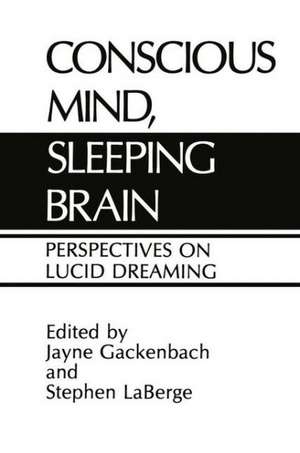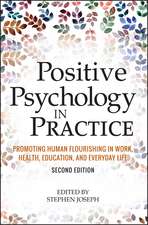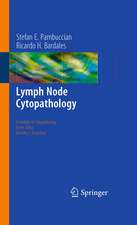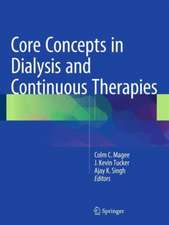Conscious Mind, Sleeping Brain: Perspectives on Lucid Dreaming
Editat de J. Gackenbach, S. LaBargeen Limba Engleză Paperback – 15 iun 2012
Preț: 1167.95 lei
Preț vechi: 1229.41 lei
-5% Nou
Puncte Express: 1752
Preț estimativ în valută:
223.56€ • 242.92$ • 187.91£
223.56€ • 242.92$ • 187.91£
Carte tipărită la comandă
Livrare economică 21 aprilie-05 mai
Preluare comenzi: 021 569.72.76
Specificații
ISBN-13: 9781475704259
ISBN-10: 1475704259
Pagini: 468
Ilustrații: 468 p. 8 illus.
Dimensiuni: 152 x 229 x 25 mm
Greutate: 0.68 kg
Ediția:Softcover reprint of the original 1st ed. 1988
Editura: Springer Us
Colecția Springer
Locul publicării:New York, NY, United States
ISBN-10: 1475704259
Pagini: 468
Ilustrații: 468 p. 8 illus.
Dimensiuni: 152 x 229 x 25 mm
Greutate: 0.68 kg
Ediția:Softcover reprint of the original 1st ed. 1988
Editura: Springer Us
Colecția Springer
Locul publicării:New York, NY, United States
Public țintă
ResearchDescriere
A conscious mind in a sleeping brain: the title of this book provides a vivid image of the phenomenon of lucid dreaming, in which dreamers are consciously aware that they are dreaming while they seem to be soundly asleep. Lucid dreamers could be said to be awake to their inner worlds while they are asleep to the external world. Of the many questions that this singular phenomenon may raise, two are foremost: What is consciousness? And what is sleep? Although we cannot pro vide complete answers to either question here, we can at least explain the sense in which we are using the two terms. We say lucid dreamers are conscious because their subjective reports and behavior indicate that they are explicitly aware of the fact that they are asleep and dreaming; in other words, they are reflectively conscious of themselves. We say lucid dreamers are asleep primarily because they are not in sensory contact with the external world, and also because research shows physiological signs of what is conventionally considered REM sleep. The evidence presented in this book-preliminary as it is-still ought to make it clear that lucid dreaming is an experiential and physiological reality. Whether we should consider it a paradoxical form of sleep or a paradoxical form of waking or something else entirely, it seems too early to tell.
Cuprins
1 Introduction.- I. Historical and Cultural Perspectives on Lucid Dreaming.- 2 Lucid Dreaming in Western Literature.- 3 Lucid Dreams in Tibetan Buddhism.- The Six Topics of N?rop?.- The Teaching on Lucid Dreams.- Dream Meditation.- Distinguishing Metaphysics from Phenomena.- 4 Lucidity, Sex, and Horror in Senoi Dreamwork.- Aims of This Section.- Gender and Dreams.- Are Senoi Women Oppressed?.- Senoi Notions of Sex and Gender.- Senoi Categories of Altered States of Consciousness.- Dreams.- Familiars.- Gender and Sacred Fluids.- Creative Blood.- Spiritual Powers.- Great Adepts: Lucidity and Transformation.- Summary and Conclusions.- Who Needs Trance?.- Conclusion.- References.- II. Empirical Approaches to the Study of Lucid Dreaming.- 5 From Spontaneous Event to Lucidity: A Review of Attempts to Consciously Control Nocturnal Dreaming.- Methodological Considerations.- Demand Characteristics.- General Situational Effects.- Day Residue.- The Subject’s Internal Processes.- The Addition of an Altered State Procedure.- State Changes Resulting from Sleep.- Inquiry Variables.- Analysis Variables.- Controlling Dream Content by Implicit Suggestion.- Overt Presleep Suggestion Studies.- Posthypnotic Control of Dream Content.- Lucid Dreaming.- Why is Dream Control Important?.- Conclusions.- References.- 6 Lucid Dream Induction: An Empirical Evaluation.- Theoretical Framework.- Duality of Thought.- Relationship between the Dual Thought Processes.- Duality of Lucid Dreaming.- Conditions Associated with Lucid Dream Onset.- Presleep and Pre-REM Conditions.- Electrophysiological Variables.- Dream Phenomenology.- Discussion: Lucid Dream Onset.- Lucid-Awareness Training.- Personal Accounts.- Alpha Feedback Training.- Waking Fantasy Training.- Discussion: Lucid-Awareness.- Intention and Suggestion Techniques.- Action-Specific Intention.- Mnemonic Induction of Lucid Dreams (MILD).- Posthypnotic Suggestion (PHS).- Discussion: Intention and Suggestion.- Cue “REM-Minding” Techniques.- Tactile Cues.- Auditory Cues.- Discussion: Cue “REM-Minding”.- Additional Techniques.- Combined Techniques.- Hypnagogic Lucidity Techniques.- Conclusion.- References.- 7 The Psychophysiology of Lucid Dreaming.- Lucid Dreaming Physiologically Verified.- Physiological Correlates of the Initiation of Lucid Dreams.- The Temporal Distribution of Lucid Dreams.- EEG Activity during REM Lucid Dreams.- NREM Lucid Dreams.- Psychophysiological Relationships during REM Sleep.- References.- 8 Correspondence during Lucid Dreams between Dreamed and Actual Events.- Methods.- Results.- Eye-Movement Signals and Hand Movements.- Scanning Movements.- Body Movements.- Digit Movements.- Memory and Mentation.- Speech.- Conclusions.- “Volitional” Actions in Lucid Dreams.- Sensations in Lucid Dreams.- Consciousness in Lucid Dreams.- References.- 9 Psychological Content of Lucid versus Nonlucid Dreams.- Self-Evaluations of Content.- Sensations and Perceptions.- Cognitions.- Emotions.- Summary of Self-Evaluations of Content.- Judges’ Evaluations of Content.- Methodological Considerations.- Samples.- Instrument.- Procedure.- Results.- Students.- Sample Comparisons.- Discussion.- Conclusions.- References.- 10 Individual Differences Associated with Lucid Dreaming.- Methodology.- Lucid Dreaming Incidence.- Oculomotor/Equilibratory Differences.- Conclusions.- Visual/Imaginal Differences.- Spontaneous Waking Imagery.- Induced Waking Imagery.- Conclusions.- Intellectual/Creative Differences.- Personal/Interpersonal Differences.- Demographic Differences.- Personality Differences.- In Review.- References.- III. Personal Accounts and Clinical Applications.- 11 A Model for Lucidity Training as a Means of Self-Healing and Psychological Growth.- Retrospective View of My Own Work with Lucid Dreams.- Basic Theoretical Principles.- Empirical Research Surveyed.- Phenomenological Experiments on Interactions with Dream Figures.- Problem.- Method.- Results and Conclusion.- Empirical Investigation of a Self-Healing Program Using Lucid Dreams.- Problem.- Method.- Results and Conclusion.- Case Studies of a Psychotherapeutic Program Using Lucid Dreams.- Problem.- Method.- Results and Conclusion.- Supplements.- References.- 12 Clinical Applications of Lucid Dreaming Introductory Comments.- Creative Lucid Dreams.- Working within the Lucid Dream.- Lucid Dreaming: Using Nightmares and Sleep—Wake Confusion.- Learning to Become Fully Lucid: A Program for Inner Growth.- Implications of the Fact That One Is Dreaming.- Dreamers Are the Primary Creative Sources of Their Dreams (CS).- Dreamers Can Recognize Aspects of the Self in the Dream Environment (SE).- The Dream World is an Alternate Reality (AR).- Individualizing Lucidity Training.- References.- 13 Personal Experiences in Lucid Dreaming.- Personal History Relating to Lucid Dreams.- Childhood.- Early Adolescence.- Late Adolescence and Early Adulthood.- First Laboratory Experiments.- Signaling from Lucid Dreams.- Experiments at Home.- Experimental Method.- Results.- Discussion.- Conclusion.- Update.- References.- 14 Without a Guru: An Account of My Lucid Dreaming.- Experimentation in Lucid Dreams.- Religious Significance of Lucid Dreams.- The Experience of Light.- IV. Theoretical Implications of This New Research.- 15 Out-of-the-Body Experiences and Dream Lucidity: Empirical Perspectives.- The Statistical Association.- A Functional Connection.- Bases of the Statistical Association.- The Theory of Phenomenological Equivalence.- The Possibility of Neurophysiological Equivalence.- The Search for Common Factors.- References.- 16 A Theory of Lucid Dreams and OBEs.- Model Building.- Reality.- Altered States of Consciousness.- Out-of-the-Body Experiences.- Lucid Dreams.- Selfless States.- References.- 17 Lucid Dreams in Their Natural Series: Phenomenological and Psychophysiological Findings in Relation to Meditative States.- The Phenomenology of Lucid Dreams and Related Phenomena.- Dream Lucidity in Relation to Normative Dreaming and Dream Bizarreness.- Lucid and Control Dreams in Their Natural Series.- Further Parallels between Lucidity and Meditation.- Psychophysiological and Phenomenological Investigations of Lucid Dreams.- First Study.- Second Study.- Third Study.- Conclusions.- Self-Reference and Transitional Organismic States.- Dream Bizarreness and Lucidity.- Lucidity and the Meditative Attitude.- References.- 18 Action and Representation in Ordinary and Lucid Dreams.- to Concepts.- Intentional and Deliberate Action.- Self-Awareness and Responsibility.- Ordinary Dreams.- Lucid Dreams.- Conclusions.- References.- 19 Dream Psychology: Operating in the Dark.- References.










